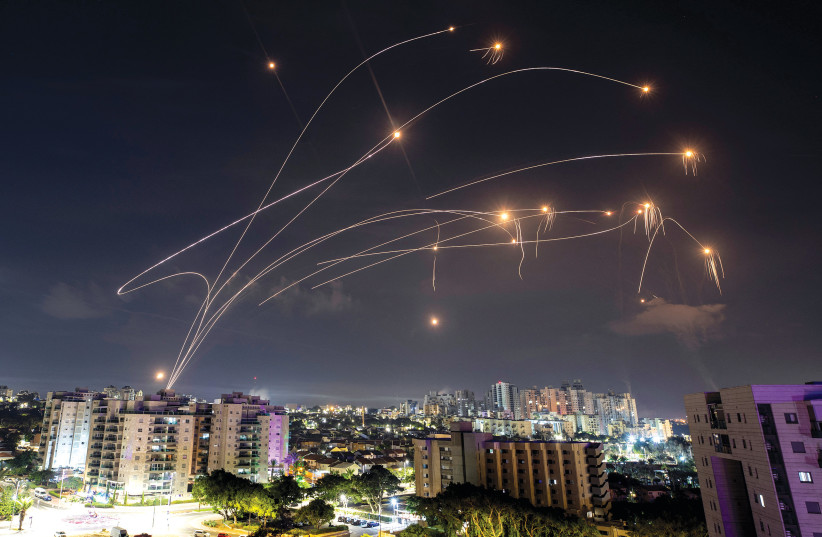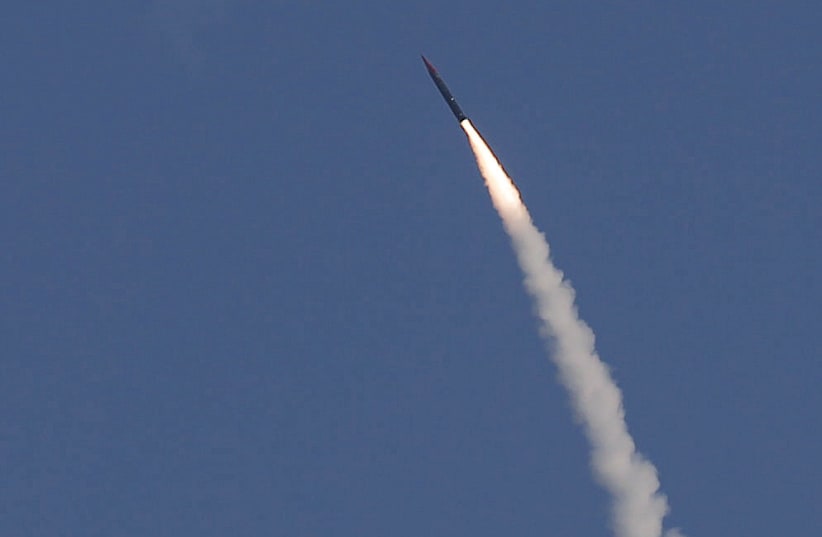Was the region transformed on Tuesday with the interception of a missile fired by Yemen’s Houthis by Israel’s Arrow missile?
On Tuesday, it was announced that the Arrow missile defense system shot down a ballistic missile for the first time, in this instance fired at Israel by Iran’s proxies in Yemen.
The Arrow system, developed by Israel Aerospace Industries in conjunction with the Israeli and US defense establishments "demonstrated today that Israel possesses the most advanced technology for defense against ballistic missiles at various ranges," said IAI CEO and President Boaz Levy.
However, this was not the first time the Arrow shot something down. In 2017, it shot down a Syrian surface-to-air missile that missed Israeli aircraft and sailed into Israeli airspace.
But Uzi Rubin, “the father of the Arrow,” and a fellow at the Jerusalem Institute for Security and Strategy, pointed out that the ballistic missile from Yemen was a much more difficult target and was the quality of target for which the Arrow was produced.
In contrast, Rubin, who is also associated with the Begin Sadat Center for Strategic Studies, stated that the Arrow’s use in 2017 was more of an out-of-the-box use of the Arrow, which had not really proven that it would be successful against a higher-quality threat, like ballistic missiles.


The Arrow: The top tier of the Israeli missile defense shield
The Iron Dome has gotten most of the media coverage for the last decade or so because it is the main tool for shooting down a large quantity of lower-quality short-range rockets, which Hamas possesses, and which Hezbollah has used occasionally.
But the Arrow is the top tier of Israel’s missile shield (David’s Sling in the middle tier, which can shoot down a bit of everything, in particular cruise missiles.)
So the good news, according to Rubin, is that Israel can now present to Iran and the rest of the region that it has a fully operational missile defense against ballistic missiles.
In 2022, then-US CENTCOM chief Gen. Kenneth McKenzie said that Iran had over 3,000 ballistic missiles, not counting its increasing number of cruise missiles.
Only a portion of these can reach Israel, but the point is that since the 1990s, the Islamic Republic has had weapons that could reach Israel, and while Jerusalem hoped that its Arrow missile shield would hold up, it had never been fully tested.
Certainly, it was a shot of confidence in the arm when Germany purchased the Arrow system, with a historic signing last month.
But there is nothing like actually shooting down a high-quality ballistic missile threat with all of the real stress of an operational situation.
And Israel managed to do this despite juggling threats on multiple other fronts: the South, the North, and ongoing in the West Bank.
From this perspective, the Arrow’s success is a new message to Tehran that neither it nor its proxies can easily harm Israel, even with their most sophisticated long-range weapons.
This boosts the Jewish state at a critical time when there are still questions about whether it can topple Hamas if it must compete with other regional distractions.
But Rubin said the boost only goes so far.
He noted that Hamas has managed to at times overwhelm Iron Dome with quantity, and that Iran and its proxies could, if they decide to take the plunge, do the same against the Arrow missile shield.
The difference would be that each Hamas rocket that gets through still does limited damage. A long-range ballistic missile could be far more precise in what it strikes and it could cause far more damage.
In that sense, Rubin said the fact that Iran’s Yemen proxies tried to hit Israel with a ballistic missile, though they failed, was as big news as the fact that the missile was shot down.
He said it meant that Iran and its proxies have significantly raised the stakes, even beyond attempts last week by proxies in Yemen to attack Israel using drones.
In that case, the US shot down the drones, but Rubin’s point was that the ballistic missile that was fired was a much higher quality and more dangerous weapon than even the drones.
While the US naval forces in the region might also be able to shoot down ballistic missiles targeting Israel, that ability might depend on the trajectory of the missile, whereas the Arrow shield is positioned in a different way and has more versatile capabilities to shoot down ballistic missiles.
So there are still many questions about new threats Israel may see from Iran and its proxies before this war closes, but at least Jerusalem has embarrassed the Shi’ite axis one time, and maybe this one time will force the ayatollahs to think harder about whether pulling out more ballistic missiles is worthwhile.
